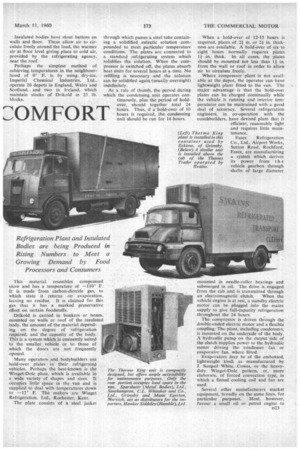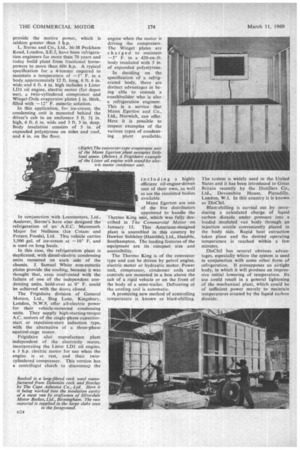COLE ZOMFORT
Page 76

Page 77

Page 78

If you've noticed an error in this article please click here to report it so we can fix it.
By Tom Walkerley
THE enormously increased consumption of quick-frozen foods in the past year or two has brought with it the problem of specialized transport to a rapidly widening circle of operators. It demands expensive refrigeration plant and well-insulated bodywork. It is important that the operator should specify in his order to the coachbuilder the precise purpose for which the vehicle is to be used.
Common errors in designing a cold vehicle are those of demanding too high or too low a degree of refrigeration. Frozen vegetables are one thing: fish is another. The vehicle desiened to hold a frozen pack at 0° F. is not the one most economically suited to transport kippers at 36° F.
There is also the problem of the distance involved in distribution. Trunking a load of meat from Liverpool to London presents fewer problems than local shop deliveries, because in the former instance the loading doors will not be opened until the destination is reached.
Any infiltration of. the ambient air results in a rapid rise in temperature. Once the temperature rises above a fairly rigid tolerance figure, there is a good chance that the load will be Inedible and a total foss. Many traders refuse to accept loads more than 5° F. above their specified temperature. There is virtually no such thing as a general-purpose cold van. Each must be built for a particular purpose if it is to be both efficient and economic. That purpose must be made known to the bodybuilder from the start, together with a good deal of other information, such as the temperature of the product on loading, body space and maximum ambient temperature expected. It is perfectly possible to maintain 0°F. in the desert.
There are, of course, many products that need not be transported at temperatures below freezing point, but demand protection, particularly in thc summer months. Fresh fish, for example. is successfully carried in insulated vans without any elaborate freezing plant, at least during the winter. Wet fish, however, is normally packed in chipped ice. Thermal insulation of vehicle bodies presents problems of its own. As always, the operator and coachbuilder are faced with the economic factors of weight, space and cost. There are several main groups of insulant, often similar material known by different trade names, and bodybuilders tend to select one that suits them, rejecting the others except for special orders.
Developments in the plastics industry have been of direct benefit. Such material as cork is now rarely used and two of the most effective insulants in common use are expanded polystyrene and Rocksil.
Polystyrene comes in white bricks which are easy to Work into the body recesses, where it. retains its shape indefinitely. Rocksil is a mineral product, quarried by Cape Asbestos in Scotland. It has not, perhaps, quite the same " body" as polystyrene—it has a woolly texture—but its fluidity enables it to be pressed into awkward corners to provide excellent sealing. Properly applied, it does not "pack down" at the bottom of the insulated space.
Whatever the insulant material specified, it is essential that the inner skin of the body should have no metal-to-metal contact with the outer skin, for this could be a source of much heat loss. The effective sealing of doors is another matter to which the bodybuilder will devote a great deal of attention. Insulated bodies have stout battens on walls and floor. These allow air to circulate freely around the load, the warmer air at floor level giving place to cold air, provided by the refrigerating agency, near the roof.
Perhaps the simplest method of achieving temperatures in the neighbourhood of 0° F. is by using dry-ice, Imperial Chemical Industries, Ltd.. operate 20 depots in England, Wales and Scotland, and two in Ireland, which maintain stocks of Drikold in 25 lb, blocks.
This material resembles compressed snow and has a temperature of —110 F. It is madefrom carbon-dioxide gas, to which state it returns on evaporation, leaving no residue. It is claimed for this gas that it has a marked preservative effect on certain foodstuffs.
Drikold is carried in bunkers or boxes, mounted on walls or roof of the insulated body, the amount of the material depending on the degree of refrigeration required, and the capacity of the body. This is a system which is eminently suited to the smaller vehicle or to those of which the doors are not frequently opened. _
Many operators and bodybuilders use hold-over plates in their refrigerated vehicles. Perhaps the best-known is the Winget-Dole plate, which is available in a wide variety of shapes and sizes. It occupies littlespace in the van and is supplied to deal withtemperatures down to —12' F. The makers are Winget Refrigeration, Ltd., Rochester, Kent,
The plate consists of a steel jacket
through which passesa steel tube" containing a solidified. eutectic solution compounded to meet :particular temperature conditions. The plates are connected to a standard refrigerating system which solidifies the solution. When the corn'pressor is switched off, the plates absorb heat units for several hours at a time. No refilling is necessary. and the. solution can be solidified again. (usually overnight)
indefinitely. ,
Asa rule of thumb, the period during which the condensing unit operates continuously, plus the period, of holdover, should: together total 24 hours. Thus, if a hold-over of 10 hours is required, the condensing unit should be run for 14 hours.
When a hold-over of 12-15 hours is required, plates.of 2i in. or 21 in, thickness are available. A hold-over of six•tp eight hours normally requires plates 14in, thick. • In all cases, the plates should be mounted not less than in. from the wall or roof in order to allow air to circulate freely. • Where compressor plant is not available at the depot, the operator can have lightweight plant fitted to the van. The major advantage is that the hold-over plates can be charged continually while the vehicle is nnining and interior ternperatufes can be maintained with a good deal of accuracy. Several refrigeration engineers, in co-operation with the coachbuilders, have devised plant that is efficient, reasonably light and requires little maintenance.
Essex Refrigeration Co., Ltd., Airport Works, Sutton Road, Rocbford, Essex, are manufacturing a system which derives its power from t h e vehicle gearbox through shafts of large diameter mounted in needle-roller bearings and submerged in oil. The drive is engaged from the cab and is transmitted through an electromagnetic clutch. When the vehicle engine is at rest, a standby electric motor can be plugged into the mains supply to give full-capacity refrigeration throughout the 24 hours.
The compressor is driven through the double-ended electric motor and a flexible coupling. The plant, including condensers, is mounted on the underside of the body. A hydraulic pump on the output side of the clutch supplies povver to the hydraulic motor driving thd condenser fan or evaporator fan. where fitted.
Evaporators may be of the emboSsed, lightweight kind, as manufactured by I. Sanwel -White, Cowes, or • the heavyduty, Winget-Dole pattern, or, more elaborate, of forced convection type, in which a finned cooling coil and fan are used.
Several other manufacturers market equipment, broadly on the same lines, for
particular, purposes. Most, however, favour a small oil or petrol engine to
provide the motive power, which is seldom greater than 3 h.p.
L. Sterne and Co., Ltd., 36-38 Peckham Road, London, S.E.5, have been refrigeration engineers for more than 70 years and today build plant from fractional horse. powers to more than 600 h.p. A typical specification for a 4-tanner required to maintain a temperature of —.5° F. in a body approximately 12 ft. long, 6 ft. 6 in. wide and 6 ft. 4 in. high includes a Lister LD1 oil engine, electric motor (for depot use), a twin-cylindered compressor and Winget-Dole evaporator plates I in. thick, filled with —12 F. eutectic solution.
In this application, for ice-cream, the condensing unit is mounted behind the driver's cab in an enclosure 3 ft. 3i in. high, 6 ft. 6 in. wide and 3 ft. 3 in. deep. Body insulation consists of 5 in. of expanded polystyrene on sides and roof, and 4 in. on the floor.
In conjunction with Locomotors, Ltd., Andover, Sterna's have also designed the refrigeration of an A.E.C. Mammoth Major for Neilsons (Ice Cream and Frozen, Foods), Ltd. This vehicle carries 3,500 gal, of ice-cream at —10' F. and is used on long hauls.
In this case, the refrigeration plant is duplicated, with diesel-electric condensing units mounted on each side of the chassis. J. Samuel White non-eutectic plates provide the cooling, because it was thought that, even confronted with the failure of one of the independent condensing units, hold-over at 0' F. could be achieved with the doors closed.
The Frigidaire division of General Motors, Ltd., Stag Lane, Kingsbury, London, N.W.9, offer all-electric power for their vehicle-mounted condensing units. They supply high-starting-torque AC. motors of the single-phase capacitorstart or repulsion-start induction type, with the alternative of a three-phase squirrel-cage motor.
Frigidaire alsti manufacture plant independent of the electricity mains: incorporating the Lister LD1 oil engine, a 3 h.p. electric motor for use when the engine is at rest, and their twincylindered compressor. This version has a centrifugal clutch to disconnect the
engine when the motor is driving the compressor. The Winget plates. are charged to maintain —5' F. in a 420-cu.-ft. body insulated with 5 in. of expanded polystyrene.
In deciding on the specification of a refrigerated body, there are distinct advantages in being able to consult a coachbuilder who is also a refrigeration engineer. This is a service that Mann Egerton and Co., Ltd., Norwich, can offer. Here it is possible to inspect examples of the various types of condens
ing plant available.
including a highly efficient oil-engine-driven unit of their own, as well as see the insulated bodies available.
Mann Egerton are one of the five distributors appointed to handle the Thermo King unit, which was fully described in The Commercial Motor on January 15. This American-designed plant is assembled in this country by Hawker Siddeley (Hamble), Ltd., Harnble, Southampton. The leading features of the equipment are its compact size and accessibility.
The Thermo King is of the convector type and can be driven by petrol engine, electric motor or hydraulic motor. Power unit, compressor, condenser coils and controls are mounted in a box above the cab of a rigid vehicle or on the front of the body of a semi-trailer. Defrosting of the cooling coil is automatic.
A promising new method of controlling temperature is known as blast-chilling.
The system is widely used in the United States and it has been introduced to Great Britain recently by the Distillers Co., Ltd., Devonshire . House, Piccadilly, London, W.I. In this country it is known as DisChil.
Blast-chilling is carried out by introducing a calculated charge of liquid carbon dioxide under pressure into a loaded insulated van body through an injection nozzle conveniently placed in the body side. Rapid heat extraction takes place and the desired operating temperature is reached within a few minutes.
DisChil has several obvious advantages, especially where the system is used in conjunction with some other form of refrigeration. It presupposes an airtight body, in which it will produce an impressive initial lowering of temperature. Its use could result in a general lightening of the mechanical plant, which could he of sufficient power merely to maintain temperatures created by the liquid carbon dioxide.




































































































































